Top 5 Oils & Butters to Treat Cracked Heels at Home
Introduction
- One of the most prevalent foot care issues that people of all ages deal with is cracked heels, sometimes referred to as heel fissures. Cracked Heels Treatment Cracked heels may initially seem like a minor cosmetic concern, but if left untreated, they can cause pain, bleeding, and in extreme situations, infections. The first step to having soft, healthy, and well-nourished feet is knowing why heels break and how natural oils and butters can aid in their recovery.
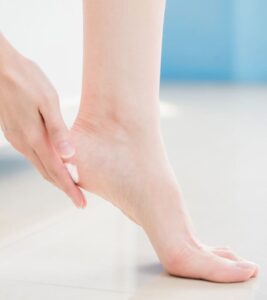
- Why Cracked Heels Happen
- The loss of suppleness and moisture in the skin surrounding the heels is typically the cause of cracked heels. In comparison to other areas of the body, this skin is inherently thicker and less flexible. It is more likely to split if it is neglected or dries out. This is caused by a number of factors:
- Dryness & Dehydration: The skin can lose its natural oils due to dehydration, which can occur both internally (drinking insufficient water) and topically (being exposed to dry air or harsh soaps).
- Neglect & Improper Foot Care: Heel damage can be accelerated by neglecting regular exfoliating, walking barefoot on uneven terrain, or skipping moisturizing.
- Weather: The skin surrounding heels is more prone to cracking in cold winters, hot summers, or low humidity conditions.
- Medical Conditions: Chronic cracked heels are associated with diabetes, psoriasis, dermatitis, thyroid problems, and obesity.
- Lifestyle Factors: Using strong detergents that come into contact with the skin, standing for extended periods of time, or wearing shoes that are too small can all exacerbate heel dryness.
- In addition to preventing heel fissures, identifying these causes aids in selecting the best treatments.
- Importance of Natural Remedies for Healing
- Natural therapies are safe and effective for the following reasons:
- Deep Moisturization: Shea, cocoa, and kokum butters are quite occlusive, which means they retain moisture and stop further drying out.
- Repairing the Skin Barrier: Oils like coconut, almond, and olive help rebuild the skin’s barrier, which keeps bacteria and irritants out.
- Anti-inflammatory and healing qualities Compounds that lessen inflammation, ease pain, and encourage wound healing are found in many natural oils.
- Safe for Extended Use Oils and butters can be used on a daily basis without experiencing severe adverse effects because they are natural and free of chemicals.
- Accessible & Affordable: The majority of these treatments are inexpensive fixes for cracked heels because they can be readily found in local supermarkets or kitchens.
- Furthermore, the benefits of oils and butters for foot care have long been highlighted by traditional practices from various cultures, including Ayurveda, Chinese medicine, and home remedies. These days, scientific research also demonstrates how well they moisturize and repair dry, damaged skin.
- In addition to healing current cracks, regular use of natural remedies can shield your feet from further harm and keep them pain-free, elastic, and smooth.
- Natural therapies are safe and effective for the following reasons:
- Numerous medicinal ointments and foot lotions are available in the beauty and health sector nowadays that promise to cure cracked heels. But because of their holistic healing qualities, natural oils and butters are particularly noteworthy. They are rich in fatty acids, vitamins, antioxidants, and emollients that thoroughly penetrate the skin, repair damage, and restore softness—all of which are lacking in synthetic formulas.
1. Coconut Oil – Deep Moisturizer for Dry Heels
- Rich in Fatty Acids for Intense Hydration
- One of the most traditional and reliable natural treatments for cracked heels is coconut oil. It is well-known for its occlusive and emollient qualities, which provide a protective layer on the skin to stop water loss and lock in moisture. The high concentration of medium-chain fatty acids (MCFAs) in coconut oil, especially lauric acid, caprylic acid, and capric acid, is what sets it apart. These fatty acids nourish cells from within and restore lost suppleness by penetrating deeply into the layers of the skin.
- Furthermore, vitamin E, a potent antioxidant that heals damaged skin and combats free radicals that cause the skin around the feet to age too quickly, is abundant in coconut oil.
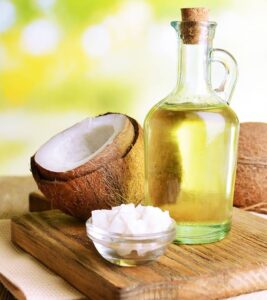
- How to Apply Overnight for Best Results
- Coconut oil works well as an overnight remedy for cracked heels. Applying at night enables the skin to absorb nutrients thoroughly without being hampered by dust and pollution exposure or walking. Here’s a detailed guide to optimize its therapeutic effects:
- Cleanse Your Feet: To get rid of bacteria, perspiration, and grime, wash your feet with lukewarm water and a mild cleanser. Soak them for ten minutes in warm water with a pinch of Epsom salt for added care. In addition to opening pores for improved absorption, this softens tough skin.
- Exfoliate Lightly: Gently exfoliate dead skin cells from the heel area using a foot scrub or pumice stone. Avoid scrubbing too vigorously if cracks are deep, as this may increase irritation.
- Massage liberally: For at least five to ten minutes, massage your heels in circular motions after applying the oil. This increases fatty acid absorption and blood circulation.
- After applying, put on fresh cotton socks to seal in the moisture. This keeps heels hydrated throughout the night and retains oil, preventing it from rubbing off on linens.
- practice Every Day: For at least seven to ten days, practice this ritual every night in order to see effects.
2. Shea Butter – Nature’s Healing Balm
- High in Vitamins A & E for Skin Repair
- Cracked Heels Treatment Shea butter has been used for centuries as a preventive and skin-healing balm. It is made from the nuts of the African shea tree (Vitellaria paradoxa). Its strong vitamin profile and deeply nourishing fatty acids make it especially useful for damaged heels.
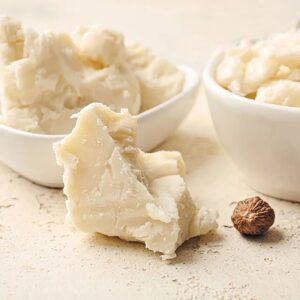
- Two key vitamins make shea butter a natural healer:
- Vitamin A: Reduces skin roughness, accelerates wound healing, and encourages cell renewal. For cracked heels, where the skin needs to be repaired quickly, this is essential.
- Vitamin E is a potent antioxidant that strengthens the skin barrier, promotes the formation of collagen, and helps lower inflammation.
- In addition to these, stearic, oleic, and linoleic acids found in shea butter help to replenish skin lipids and restore suppleness. Shea butter is a great overnight treatment for extremely dry heels because of its solid structure, which guarantees long-lasting hydration in contrast to lighter moisturizers that quickly evaporate.
- Current dermatological research supports the long-held belief in traditional African medicine that shea butter works well for eczema, fissures, and xerosis, or unusually dry skin.
- Locks in Moisture & Softens Rough Skin
- Shea butter’s occlusive properties are one of the primary reasons it is unique in foot care. When applied, it draws moisture into the skin and forms a barrier that keeps water from escaping. Cracked heels require this dual function of protection and hydration.
- Shea butter helps tough heels in the following ways:
- Deep Moisturization: Provides strong hydration by penetrating the thick layers of skin on the heels.
- Softens Calluses: Hardened, thickened areas around the heels become noticeably smoother and gentler with regular application.
- Prevents Infections: It lessens the possibility of germs and fungi getting into open fissures by caulking small cracks and improving skin barrier function.
- Long-Lasting Effects: Shea butter provides ongoing nourishment to the skin for a longer period of time than lotions, which tend to wash off rapidly.
- How to Use Shea Butter for Cracked Heels
- Direct Application: Massage a pea-sized quantity of raw, unrefined shea butter onto the heels following cleansing and exfoliation. Put on cotton socks and go to bed for the night.
- DIY Heel Balm: To create a thicker heel balm for tenacious fissures, mix shea butter with beeswax or coconut oil.
- Daily Moisturizer: To seal in moisture and avoid drying out, dab on a little after taking a shower.
3. Almond Oil – Vitamin-Rich Nourishment
- Lightweight Oil Packed with Vitamin E
- One of the mildest yet most effective natural treatments for cracked heels is almond oil, which is extracted from sweet almonds (Prunus amygdalus). Almond oil is lightweight and absorbs quickly, unlike heavy oils or thick butters, which makes it perfect for daily use without leaving a greasy residue.
- Vitamin E, also known as the “skin vitamin,” is the main ingredient in almond oil. It is a strong antioxidant that promotes smoother, healthier skin, protects against oxidative stress, and heals damaged skin tissue. When skin cells are fragile and unable to hold onto moisture, cracked heels frequently result. Vitamin E helps the skin recover from the inside out.
- In addition to Vitamin E, almond oil contains:
- Vitamin A: Reduces rough spots by promoting the production of new cells.
- Omega-3 fatty acids: Prevent dryness and preserve the lipid barrier of the skin.
- Magnesium and zinc aid in tissue repair and skin healing.
- Almond oil reduces irritation and increases skin hydration and suppleness, according to scientific research published in the Journal of Cosmetic Dermatology. This makes it a protective treatment for sensitive or irritated cracked heels in addition to being a moisturizing agent.
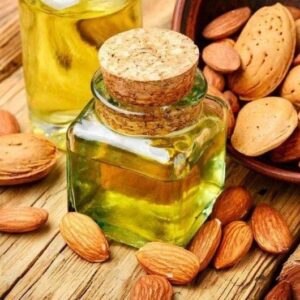
- Restores Elasticity & Smoothness to Heels
- The ability of almond oil to restore skin suppleness is one of the main reasons it is highly recommended for cracked heels. When walking or standing, the heels experience continuous pressure and friction, which frequently leads to the skin becoming hard and splitting. The emollient qualities of almond oil restore elasticity and soften the tough skin layers, halting further cracks.
- Here’s how almond oil benefits rough, cracked heels:
- Hydration Boost: Provides long-lasting moisture by deeply penetrating the layers of the skin.
- By making the skin more elastic, Elasticity Restoration lowers the chance of deep cracks.
- Scar Healing: Aids in the fading of scars from small cuts or old fractures.
- Soothing Action: Lessens the itching, irritation, and inflammation that are frequently linked to dry, cracked heels.
- Anti-Aging for Feet: Keeps the skin on your heels smooth and young by preventing early thickening and wrinkles.
- How to Use Almond Oil for Cracked Heels
- Before going to bed, gently massage your clean heels with 1-2 teaspoons of warm almond oil. To keep the oil locked in overnight, put on cotton socks.
- Calm Foot Soak: For a nourishing foot soak, mix a few drops of almond oil with warm water. Prior to exfoliation, this helps to soften tough skin.
- DIY Heel Cream: For a more luxurious homemade heel care balm, combine almond oil with beeswax or shea butter.
4. Olive Oil – The Ancient Remedy
- Natural Emollient for Cracked, Flaky Skin
- For thousands of years, olive oil—often referred to as “liquid gold” in the Mediterranean region—has been a part of skincare and therapeutic practices. It is one of the best natural emollients for cracked heels and is high in antioxidants and monounsaturated fatty acids. Olive oil creates a protective layer over the skin, helping it retain moisture and heal itself over time, in contrast to lighter oils that evaporate rapidly.
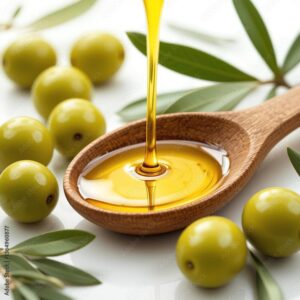
- The two main components that make olive oil effective for heel care are:
- Deeply penetrating the skin, oleic acid is a fatty acid that softens and restores suppleness to thick, calloused areas.
- Strong antioxidants that prevent oxidative damage, encourage tissue regeneration, and reduce inflammation are polyphenols and vitamin E.
- Cracked heels frequently have a rough, flaky, and dry appearance. These problems are directly addressed by olive oil, which nourishes skin cells, lessens flakiness, and stops more splitting. Dermatologists recommend olive oil as a treatment for dry, cracked heels because it improves skin hydration and suppleness, according to scientific research published in the Journal of Food Science and Nutrition.
- Furthermore, the moderate antibacterial qualities of olive oil lower the possibility of infections that could arise from deep or exposed fractures.
- Simple Massage Method for Daily Use
- Olive oil’s ease of use is among its best qualities. Dry, cracked heels can be turned into soft, nourished skin with only a little massaged on a daily basis; no complicated formulas or pricey equipment are needed.
- Here’s how to use olive oil for everyday heel care, step-by-step:
- Cleanse Your Feet: To get rid of perspiration and grime, wash your feet with lukewarm water and a mild cleanser. Use a gentle towel to pat dry.
- Warm the Oil: For improved absorption and calming relief, slightly warm one or two teaspoons of extra virgin olive oil.
- Massage Gently: Use circular motions to massage your heels for five to ten minutes after applying the oil. This enhances blood flow and facilitates the absorption of oil into the thick layers of skin.
5. Cocoa Butter – Thick Barrier for Protection
- Creates a Protective Layer on Heels
- Theobroma cacao, the bean from which cocoa butter is produced, is one of the best natural emollients for very dry and cracked heels. It is well-known for its rich, buttery feel and functions by covering the skin with a thick, protective layer that keeps moisture in and prevents additional damage to the heels.
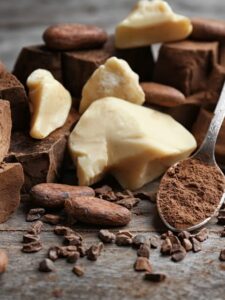
- The key components that make cocoa butter effective are:
- Stearic acid and oleic acid are fatty acids that soften harsh, hardened skin and offer great hydration.
- Natural antioxidants like vitamin E and polyphenols help to heal damaged skin cells, lower inflammation, and guard against oxidative stress.
- Natural plant sterols: promote the healing of the skin’s barrier and increase its suppleness.
- Due to their lack of natural oils, cracked heels are particularly susceptible. Walking may become uncomfortable if the fissures worsen if treatment is not received. Because of its thick viscosity, cocoa butter covers the skin, restoring lost lipids and reducing water loss. This stops new cracks from growing in addition to healing existing ones.
- Ideal for Winter Dryness & Deep Cracks
- In the winter, when the skin is deprived of its natural moisture due to low humidity and chilly winds, cocoa butter works especially well. Cocoa butter remains on the skin longer and provides continuous nourishment, in contrast to lighter oils that may absorb fast and require regular reapplication.
- Here’s why it’s so effective for winter dryness and deep cracks:
- As an occlusive agent, heavy-duty moisturizer seals moisture into the driest, hardest heel skin.
- Softens Calloused Areas: Over time, heels become smoother as rough, thicker spots are broken down.
- Prevents Further Splitting: Its protective covering lessens the likelihood of deeper splits by reducing friction from walking or shoes.
- Reduces Irritation: Anti-inflammatory substances reduce the redness, itchiness, and pain that come with cracked heels.
- Encourages Healing: Vitamin E supports the skin’s natural healing process by increasing the creation of collagen.
- How to Use Cocoa Butter for Cracked Heels
- Overnight Treatment: Before going to bed, coat your clean, exfoliated heels with a thick layer of cocoa butter. To retain the moisture, put on cotton socks and leave them on the night.
- Heel Balm Recipe: To create a softer balm that may be used every day, combine cocoa butter with a few drops of almond or coconut oil.
- Winter Shield: For optimal protection in cold weather, apply cocoa butter twice a day, in the morning and at night.
